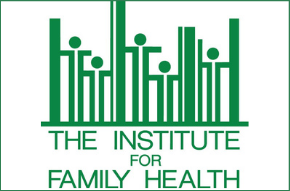Nov 06

Help Us Protect Access to Sexual and Reproductive Health Care Today!
We did it! We met our $10,000 match and raised a total of $33,000 on #GivingTuesday! Thank you!
Missed out on Giving Tuesday? You can still donate to our year-end campaign.
From now until December 31st, RHAP is raising funds to mobilize, train, and support clinicians to make reproductive health care accessible to everyone.
Here’s how your donation will help make a difference:
Together, we are creating long-lasting change and ensuring a future where everyone has access to full-spectrum reproductive health care.
Thanks to an amazing supporter, donations by new donors will be matched dollar-for-dollar, up to $20,000, if you donate by December 31st.
If you have any questions about our year-end campaign, please contact our Manager of Individual Giving, Victoria Pittl.
As always, your support keeps us inspired!
Dr. Linda Prine and Tiffany Smith, MPH, work at the Institute for Family Health, a Federally Qualified Health Center network with 17 sites across New York City and the Mid-Hudson Valley.

Over the past few years, a team of clinicians and program staff has been working on a family planning grant that functions to expand training and access to reproductive health services in New York. As the pandemic accelerated rapidly in NYC, those of us working on the grant had to shift gears quickly and adapt to the new landscape. Though there would be no on-site training in LARC (long-acting reversible contraception, which includes IUDs and the birth control implant), we wanted to maintain the availability of comprehensive contraception services for our patients. In the past few years, we had started offering SubQ Depo (a form of the birth control shot) at our health centers. However, we had not previously focused on having patients access it at their local pharmacy or self-inject at home. But as the pandemic intensified and patients became warier about coming to our centers, we started to make that switch.
Our project manager, Tiffany Smith, MPH, searched our patient base and found that there were more than 400 patients who were either overdue, due, or almost due for their next Depo shot – the Depo shot is generally given every 3 months. She started reaching out to patients via our patient portal and cold-calling. For those who were interested, she sent them an information sheet on how to inject the shot, and scheduled telehealth appointments for them with either Dr. Susan Rubin or Dr. Linda Prine. Quickly, we were spending much of our telehealth time on teaching people how to self-inject the SubQ Depo; however, insurance denials soon started to roll in with patients already overdue for birth control having to wait for approval so that they didn’t have to pay out of pocket. The insurers’ reasoning was that the SubQ Depo was not on formulary (a list of covered prescription drugs), despite the coverage of injectable contraception in the Affordable Care Act, the New York Comprehensive Contraceptive Coverage Act, and the NY Reproductive Health Act!
We sprang into action and began collaborating with the Reproductive Rights branch of the NY Civil Liberties Union (NYCLU), the NY State Academy of Family Physicians (NYSAFP), the NY City Department of Health Medicaid Managed Care (DOHMMC), and the New York State Attorney General’s office. Meanwhile, our stellar nurse, Eve Stetson, LPN, began filling out prior authorization forms by the dozens. We called insurance companies, often waiting long hold times, only to be told, “This isn’t a decision I can override…” We spoke to supervisors, supervisors’ supervisors, working our way up the chain of authority, finally making our first breakthrough with Affinity Health Plan. They acknowledged that forcing people to come into the office for this contraception that was also available from their pharmacy and could be used at home was, in fact, a matter of safety. Ultimately, they agreed to cover SubQ Depo, but only for the duration of the pandemic. Next, we got the same approval from Healthfirst.
Though we found some success with those two insurance plans, the Institute takes more than 40 different health insurance plans and getting SubQ depo covered this way was proving to be slow and arduous. With the help of the NYCLU, we got someone in the New York State Department of Health to agree to tell all Medicaid Managed Care plans to cover the medication. The NYSAFP also put pressure on Gov. Cuomo’s office to act, and the Cuomo administration eventually announced that all Medicaid Managed Care plans would have to use one main formulary. The new formulary went live and the SubQ depo was on it! Getting the SubQ depo on the formulary proved only to be the first step, as Tiffany had to make phone calls to pharmacies, coaxing them through the extra steps to verify that SubQ was both covered and stocked, rather than turn patients away to other pharmacies. Ultimately, we estimate that we converted several hundred patients to the home use formulation of the Depo shot. Moreover, the feedback from the patients was positive, as they felt good about being able to continue using their preferred birth control method while avoiding unnecessary exposure. Though many patients are still using their refills, only a few have switched back to the in-office Depo shot. Our team advocacy efforts have shown that if the pandemic intensifies again, we can maintain access to comprehensive contraception services – this is something to be proud of.

Inequities in reproductive health care, including abortion, have long existed in the United States. State legislatures have sought to erode Roe v. Wade by enacting policies that restrict or delay access to and provision of abortion services. This has primarily impacted Black, Indigenous, and People of Color (BIPOC), adolescents, and families living below the federal poverty line. With this restrictive policy climate, the ongoing coronavirus (COVID-19) pandemic has burdened health centers and patients with unprecedented logistical, financial, and medical challenges. One in three women* surveyed by the Guttmacher Institute reported that due to the pandemic, they’ve had to delay or cancel visiting their clinician for reproductive health care, or have had trouble getting their birth control.
In this article, we describe three areas of inequity (telehealth, access, and policies) observed during the pandemic and discuss potential strategies that can ensure equitable access to reproductive health care while protecting the public from ongoing COVID-19 exposure.
Inequities in Telehealth Access and Use
US health centers have rapidly adopted telehealth services to provide patients with needed continuity of care during “Stay at Home” orders and sustained social distancing measures, while also protecting patients and health care personnel from risks of virus exposure. Telehealth technology has long been used to facilitate access to health and medical information, education, and services. Reproductive health care delivery has also been part of this telehealth expansion, as much of it is well-suited to virtual interactions, such as: counseling for contraception decision-making, pregnancy options, miscarriage management options; post-abortion follow-up care; and prescribing birth control methods. In response to COVID-19, many organizations, like RHAP, have developed protocols to support “no test” or minimal touch reproductive health services such as medication abortion and contraception care.
While expanding telehealth for reproductive health care is incredibly important to reduce risks of COVID-19 exposure, this technology may not be impacting all patients equitably, particularly those already lacking access to affordable, high-quality care pre-pandemic. Engaging with the health care system through telehealth can be difficult simply due to having insufficient or inconsistent mobile phone reception or internet access. 39% of rural Americans (23.4 million people), compared to four percent of urban Americans, lack basic fixed internet service. Black and Latinx folks are less likely to have a broadband connection at home, as compared to white people. Technological issues can make it challenging to get a telehealth visit started, to provide counseling for contraception, abortion, and miscarriage care, and to ensure that patients fully understand the treatment plan.
Even with excellent phone and internet connection and availability, home may not be the safest place to have a telehealth appointment. Especially in urban areas where families live in small spaces, adolescents, for example, may not have a private, confidential space to fully open up about sensitive health concerns, such as reproductive health needs, questions, and services, without the risk of parents or guardians overhearing. Typically with in-person visits, clinicians are able to separate family and confidential conversations with adolescent patients. This division can be difficult to coordinate over telehealth, as the clinician does not have full control over the environment.
For patients with language barriers, providing reproductive health care through an interpreter over telehealth presents additional challenges. Important nonverbal cues for communication, such as body language and facial expressions, can be lost when video capability is not available. When a clinician, interpreter, and patient are trying to talk about sensitive and emotional topics, like pregnancy options or miscarriage care treatments, it can be challenging to understand a patient’s emotions, be responsive to their feelings, and support them to make informed decisions.
Restricting Access to Abortion Care
When the COVID-19 pandemic began, ten states defined abortion as a “non-essential,” or an “elective” health procedure, effectively banning abortion care until the end of the pandemic. Although these bans have been lifted, pregnant people experienced drastic consequences. In Texas, this ban lasted 31 days, leaving hundreds of pregnant people – who were in the middle of receiving options counseling, scheduling their appointment, abiding by the mandatory waiting period, driving long distances to their abortion – were thrown into limbo as to whether they could have an abortion in time, or be forced to carry an unwanted pregnancy to term. RHAP has been at the forefront of training and supporting clinicians to use a “no-test” protocol to provide medication abortion to patients. This has allowed clinicians to maximize remote care and minimize the need for patients to travel during the pandemic.
Although all counseling, needed tests, and taking the pills can be done at home, rules by the US Food and Drug Administration (FDA) require clinicians to stock and dispense mifepristone – one of the medications used in a medication abortion – onsite, in-clinic. However, experts concur that decades of safety data indicate that this regulation is not necessary. While the FDA quickly suspended similar restrictions on other less-safe drugs in recognition that these rules “put patients and others at risk for transmission of the coronavirus,” the rules on mifepristone remained in effect. This changed after a court case challenging these restrictions was heard in the spring of 2020. In ACOG v. FDA, the judge issued a preliminary injunction to temporarily suspend the regulation starting July 15th, allowing clinics to mail mifepristone to patients seeking a medication abortion. Yet, state laws continue to interfere: 19 states require the prescribing clinician to be physically present when medication abortion is provided, banning the use of telehealth for abortion care, including mailing pills.
Bodily Autonomy and Preferences for Care during COVID-19
To reduce risks of exposure during the pandemic, some health centers had been limiting the types of appointments and services available for an in-person visit. Some were urging patients to wait until conditions improve to schedule an in-person visit. While establishing such procedures allows for prioritizing services that absolutely require in-person care, it is essential to ensure that these policies do not undermine people’s bodily autonomy, agency, and preferences for health care. For example, studies demonstrate that it is safe to leave a contraceptive intrauterine device (IUD) beyond the FDA approved time of use. However, young adult women of color have reported that their preferences regarding contraceptive selection or removal are not always honored by their clinicians. Honoring patient preferences for health care and bodily autonomy, especially in situations like using long-acting reversible contraception (LARC) – in which patients mostly depend on their clinician for insertion and removal – must not be sacrificed.
Addressing Reproductive Health Inequities During COVID-19
In order to ensure that everyone has access to high-quality, patient-centered reproductive health services with dignity and compassion during and after this pandemic, we must work with the communities most vulnerable to experiencing health inequities and disparities. Eliminating inequities in reproductive health care necessitates addressing root causes and pursuing structural change in areas like housing, education, policing, economic opportunity, and neighborhood contexts, as well as dismantling laws and systems that undermine bodily autonomy. As the fight for structural change continues, the following immediate strategies may be undertaken by organizations, health centers, and individual clinicians to ameliorate additional reproductive health care inequities caused by COVID-19.
Telehealth Infrastructure
Enhancing Privacy through Telehealth
Medication Abortion Implementation and Ongoing Advocacy
Offering Both Telehealth and In-Person Visits as Desired
Footnote
*The term “women” in this article is used when referring to data in which only cis-gender, women-identifying people were studied. We acknowledge that gender non-binary, trans folks, and other people who may not identify as “women” can also get pregnant and need reproductive health care.
This commentary was written by Silpa Srinivasulu, MPH, RHAP’s Research and Evaluation Manager, and Board Member Sandra Echeverría, MPH, PhD.

2020 has been a difficult year. Like so many others, the RHAP community was deeply impacted by COVID-19. In addition to the personal impact of this pandemic, our organization faced a number of new challenges. We moved our office to be 100% remote at the beginning of the pandemic. We had to learn new rhythms, new ways of navigating the work, and how to share office and living space with new officemates (our families, roommates, and pets!). Additionally, we showed up for the clinicians who are on the front line of this pandemic – clinicians who continued to go to work every day while figuring out how to navigate this new and horrific virus and still looking to provide reproductive health care to their patients. We developed a whole new curriculum and set of resources that specifically outline how to provide abortion, miscarriage, and contraception care that is safe and patient-centered during this time. We revamped our most popular patient education resource, the birth control choices fact sheet, to be more aligned with our organizational values. We laid the groundwork to publish three new comic books (stay tuned, out in early 2021). We re-configured our Network, which has always focused on in-person meetings, to be completely virtual and to provide support to clinicians who are now facing impossible situations at work. We’ve hosted 92 online gatherings since March and launched a national “Cluster” for Advanced Practice Registered Nurses (APRN). We added two new fellowship training sites – and we now train fellows in Michigan and New Jersey, in addition to Massachusetts, New York, and Washington.
The ongoing uprising for Black lives, brought on by George Floyd’s murder at the hands of the police, pushed our organization to reflect deeply on what it takes to be anti-racist, and how we can and must do better. We have started speaking out more on issues of inequity and racial injustice, uplifting the efforts and work of Black-led justice organizations, participating in more coalitions led by BIPOC partners, and issuing statements that clearly outline our beliefs as an organization. We restructured our clinical leadership to make room for new leaders. We started a strategic planning process to focus our work over the next few years. As part of that process, we are ensuring that a racial justice lens is integrated into our organizational structures, vision, mission, and programs.
Despite the challenges we have all faced this year, the RHAP team is grateful for so many things: the technology – yes, even zoom! – that allows us to work from home and stay connected to each other; our colleagues, who show up to work every day, uphold our organizational values, and hold us accountable; the clinicians we work with all across the country; and, folks like you, who support our work during what has been a financially rough year for everyone. Thank you, and best wishes for a happy New Year.
Your gift allows us to train and support health care providers across the United States so they can offer patients compassionate and comprehensive care.
Nov 06
